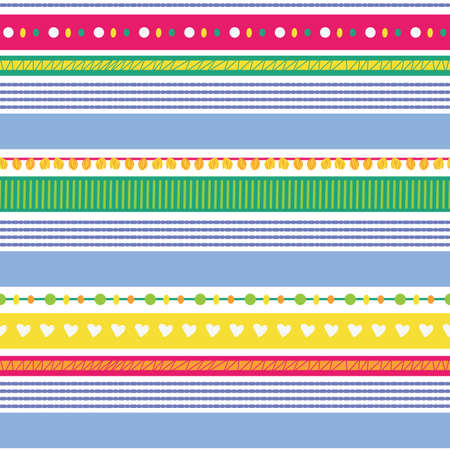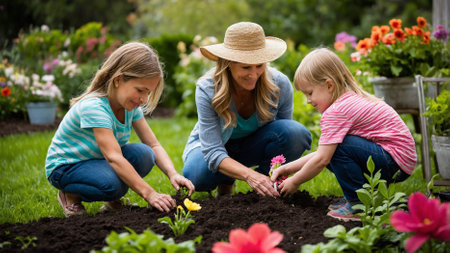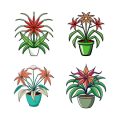Introduction to Kid-Friendly Gardens
Creating a bright and cheerful garden isn’t just about adding color to your yard—it’s about bringing families together, encouraging learning, and making the outdoors fun for kids. In many American homes, the backyard is more than a patch of grass; it’s where memories are made, from summer picnics to growing that first sunflower. A garden designed with kids in mind invites curiosity, teamwork, and a sense of wonder that everyone can share.
Why Choose a Bright and Cheerful Garden?
When gardens burst with color and playful features, they spark imagination and joy. Children naturally gravitate towards spaces that feel lively and welcoming. Whether it’s chasing butterflies, picking strawberries, or simply digging in the dirt, these experiences help kids learn about nature while having fun. For parents and caregivers, a well-planned garden becomes an outdoor classroom and a place to bond as a family.
Benefits of Kid-Friendly Gardens
| Benefit | Description |
|---|---|
| Fun & Play | Colorful plants and playful spaces turn gardening into an adventure for kids. |
| Learning Opportunities | Gardening teaches responsibility, science, and patience in a hands-on way. |
| Togetherness | Working side by side in the garden helps families connect and make lasting memories. |
| Healthy Habits | Keeps everyone active outdoors and encourages healthy eating with homegrown veggies. |
Every Family Can Join In
No matter the size of your backyard—or even if you just have a small patio—there are ways to design a space that feels bright, cheerful, and inviting for children. From colorful raised beds to sensory paths and whimsical decorations, kid-friendly gardens are all about celebrating the joy of being outside together.
2. Choosing Vibrant Plants and Flowers
When creating a bright and cheerful garden for kids and families, picking the right plants makes all the difference. You want plants that are not only colorful and fun but also safe for little hands and hardy enough to thrive in your local climate. Here’s how to select the best options for gardens across the United States.
Colorful Plants Kids Will Love
Kids are naturally drawn to bold, eye-catching colors. Picking a variety of flowers and foliage in different shades creates a playful vibe that keeps everyone interested. Think about mixing reds, yellows, oranges, purples, and blues for maximum impact.
Top Picks for Colorful, Hardy, and Safe Plants
| Plant Name | Main Colors | USDA Hardiness Zones | Safety | Fun Factor |
|---|---|---|---|---|
| Zinnias | Red, Pink, Yellow, Orange, White | 3-10 | Non-toxic | Easy to grow from seed; attracts butterflies |
| Sunflowers | Yellow, Orange, Red | 4-9 | Non-toxic (except for some ornamental varieties) | Tall stems; kids can measure their growth |
| Marigolds | Yellow, Orange, Red | 2-11 | Non-toxic (mildly irritating if ingested in large quantities) | Pest-repelling; easy for kids to plant |
| Pansies/Violas | Purple, Blue, Yellow, White, Bicolor | 6-10 (annual in colder zones) | Edible petals; non-toxic | Cute “faces” on blooms; cool weather color |
| Sugar Snap Peas | White Flowers; Green Pods | 3-11 (spring/fall crop) | Edible; non-toxic | Keeps kids snacking healthy; fun to pick and eat fresh off the vine |
| Lamb’s Ear (Stachys byzantina) | Silvery Green Foliage; Purple Flowers | 4-8 | Non-toxic; soft leaves safe to touch | Sensory plant—kids love petting the fuzzy leaves! |
| Nasturtiums | Orange, Red, Yellow Cream, Peachy Pink hues | 9-11 (annual elsewhere) | Edible flowers & leaves | Peppery taste—adds fun to salads or snacks |
Selecting Plants for Your Region
The U.S. has many different climates—from sunny Florida to chilly Minnesota. Make sure you choose plants that will thrive where you live by checking the USDA Hardiness Zone on each plant label or seed packet. If you’re unsure of your zone, look it up here on the USDA website.
Sensible Planting Tips for Families
- Avoid toxic plants: Steer clear of common garden plants like foxglove, oleander, or castor bean which can be harmful if touched or eaten.
- Add edible choices: Herbs like basil and mint or veggies such as cherry tomatoes give kids a tasty reason to visit the garden daily.
- Create themed beds: Try a “Rainbow Garden” with rows of different colored blooms or a “Butterfly Garden” using nectar-rich flowers.
Quick Tip:
- Avoid toxic plants: Steer clear of common garden plants like foxglove, oleander, or castor bean which can be harmful if touched or eaten.
- Add edible choices: Herbs like basil and mint or veggies such as cherry tomatoes give kids a tasty reason to visit the garden daily.
- Create themed beds: Try a “Rainbow Garden” with rows of different colored blooms or a “Butterfly Garden” using nectar-rich flowers.
Quick Tip:
If you have pets who use the yard too, check that your chosen plants are also animal-safe—especially if you have curious dogs or cats.
A bright and cheerful garden starts with choosing vibrant plants that are both beautiful and family-friendly. By mixing textures, colors, and kid-safe varieties suited to your region, you’ll create a space everyone will want to spend time in together!

3. Creative Pathways and Play Zones
When designing a garden for kids and families, it’s important to think beyond just plants and flowers. Adding fun pathways and special play zones can turn your backyard into an adventure spot right at home. These creative touches help spark imagination and make outdoor time even more enjoyable.
Whimsical Garden Paths
Paths invite children to explore and provide clear routes through flower beds or vegetable patches. Here are some playful ideas for making pathways:
| Path Idea | Description | Materials |
|---|---|---|
| Colorful Stepping Stones | Painted stones with fun shapes or family handprints add a personal touch. | Concrete pavers, non-toxic outdoor paint, sealer |
| Mosaic Tile Trails | Broken tiles arranged in patterns or rainbows create eye-catching trails. | Ceramic tiles, grout, sand base |
| Wooden Log Slices | Sanded log rounds offer a rustic, natural look underfoot. | Tree trunk slices, sand or gravel bed |
| Mulch Maze Paths | Soft mulch paths shaped like spirals or zigzags for safe, barefoot play. | Bark mulch, landscape fabric underneath |
Designated Spaces for Play and Imagination
A family-friendly garden thrives when there are spots just for play. These zones don’t need to be fancy—just intentional and safe:
Mud Kitchen Corner
Set up a small table or old sink with pots, spoons, and buckets. Kids can “cook” with soil, leaves, and water—perfect for creative messes!
Teepee Hideaway or Fairy House
Create a hideout using bamboo poles and canvas, or build a tiny fairy village with rocks and twigs among the flowers. These become magical spaces for stories and pretend play.
Outdoor Art Spot
Install a chalkboard wall on the fence or set out easels for painting garden scenes. Let creativity blossom in the fresh air.
Play Zone Ideas Table
| Play Zone Type | Main Features | Best Location in Garden |
|---|---|---|
| Mud Kitchen Corner | Pots, pans, old kitchen tools, water access | Shady area near hose or rain barrel |
| Teepee/Fairy House Area | Bamboo sticks, fabric cover, fairy figurines or natural decorations | Under trees or tucked in flower beds for privacy |
| Art Spot Outdoors | Easel, washable paints, chalkboards, aprons | Paved patio or flat grassy area with good light |
| Sensory Sand/Water Bin Area | Tub of sand or water toys for digging and splashing fun | Easy-to-clean surface; nearby seating for adults to watch kids play safely |
Tips for Safe and Inviting Spaces
- Use non-slip materials on pathways to prevent falls.
- Avoid thorny or toxic plants near play areas.
- Add solar lights along paths so evening strolls feel magical and safe.
By mixing colorful paths and creative play zones into your garden design, you’ll create a space where both kids and adults can relax, explore, and let their imaginations run wild.
4. DIY Garden Art and Decorations
Adding fun and colorful art to your garden is a great way to get the whole family involved. Kids love to see their creations displayed outdoors, and these simple projects encourage everyone’s creativity while brightening up your outdoor space. Here are some easy and affordable ideas you can try at home.
Painted Rocks
Painted rocks are an all-time favorite for kids of all ages. You just need some smooth stones, acrylic paint, and brushes. Let your kids paint bugs, smiley faces, or even simple patterns. Once dry, place them along pathways or around plants for a pop of color. Painted rocks also make great plant markers—just write the plant name on them!
Birdhouses
Building and decorating birdhouses is a classic family project that brings wildlife into your garden. You can find pre-made wooden birdhouses at most craft stores, then decorate them with non-toxic paints or markers. Hang them in trees or on fences and watch as birds come to visit. This project teaches kids about local birds and the importance of providing shelter for wildlife.
Recycled Art Projects
Turn everyday items into garden treasures! Use old cans as planters, decorate plastic bottles as flower pots, or create wind chimes from bottle caps and beads. These projects not only keep waste out of landfills but also help kids see the value in reusing materials. Here’s a quick guide to some easy recycled art ideas:
| Material | Project Idea | How to Use in Garden |
|---|---|---|
| Tin cans | Colorful planters | Plant herbs or small flowers; hang on fences or railings |
| Plastic bottles | Hanging pots or drip waterers | Grow small plants; use as watering devices near roots |
| Bottle caps | Wind chimes or mosaics | Add sound and visual interest near seating areas |
| Mason jars | Candle holders or lanterns | Create cozy evening lighting for family gatherings |
Family-Friendly Craft Tips
- Choose non-toxic, weather-resistant materials whenever possible.
- Let kids take the lead—imperfection adds charm!
- Make sure art projects are safe for pets and local wildlife.
- Rotate decorations with the seasons to keep things fresh and exciting.
A garden filled with homemade art feels special because it grows along with your family’s creativity. Try these easy crafts together and watch your garden become a brighter, happier space for everyone.
5. Interactive and Educational Features
When designing a bright and cheerful garden for kids and families, adding interactive and educational features makes the space not only fun but also a great learning environment. These features encourage children to explore, play, and discover the wonders of nature right in their own backyard.
Sensory-Friendly Elements
Sensory gardens are perfect for engaging all five senses. You can create areas where kids can touch soft lamb’s ear leaves, smell fragrant herbs like mint or lavender, hear wind chimes or rustling grasses, see colorful flowers, and even taste edible plants. Sensory paths made from smooth stones, wood chips, or sand let kids feel different textures underfoot as they walk or run around.
Edible Plants for Snacking and Learning
Planting fruits, vegetables, and herbs gives children the chance to pick healthy snacks straight from the garden. This hands-on experience helps them understand where food comes from and encourages healthy eating habits. Here are some easy-to-grow options that kids love:
| Plant | Why Kids Love It |
|---|---|
| Cherry Tomatoes | Sweet flavor and fun to pick |
| Strawberries | Tasty treats in early summer |
| Basil & Mint | Aromatic leaves for sensory play |
| Carrots | Fun to pull from the ground |
| Snap Peas | Crispy pods ready to eat off the vine |
Learning Stations for Curious Minds
You can set up simple learning stations throughout the garden to inspire curiosity and hands-on discovery. Consider these ideas:
- Bug Hotels: Create small habitats using sticks, pine cones, and bricks to attract helpful insects.
- Weather Watch Station: Install a rain gauge or wind spinner so kids can track weather changes.
- Compost Corner: Teach about recycling food scraps by making a kid-friendly compost bin.
- Plant Labeling Area: Let kids make their own plant markers using craft sticks or painted rocks.
- Observation Bench: Place a bench near flowers so children can watch butterflies and bees at work.
Tips for Success
Keep pathways wide enough for strollers or wheelchairs, use non-toxic plants, and involve kids in choosing what to grow. The more they help design and care for the garden, the more invested—and excited—they’ll be about spending time outdoors.
6. Safety and Accessibility Tips
When creating bright and cheerful garden designs for kids and families, safety and accessibility should always come first. A family-friendly garden isn’t just about vibrant colors and playful spaces—it’s about making sure everyone can enjoy the outdoors comfortably and securely, no matter their age or abilities.
Safe Surfaces for Play
Kids love to run, jump, and explore. Choosing the right ground cover helps prevent slips and falls. Here are some popular options:
| Surface Type | Safety Benefits | Family-Friendly Notes |
|---|---|---|
| Mulch (natural wood) | Softens falls, easy on knees | Great for play areas; check for splinters |
| Rubber Mats | Cushions impact, slip-resistant | Good under swing sets or slides |
| Lawn/Turf Grass | Gentle surface, cool in summer | Needs regular mowing; watch for allergies |
| Paved Paths (smooth concrete or pavers) | Easy for strollers, wheelchairs, walkers | Add non-slip finishes for rainy days |
Clear Pathways for All Ages and Abilities
Accessible pathways make it easy for everyone to get around the garden. Keep these tips in mind:
- Width Matters: Make paths at least 36 inches wide so wheelchairs and double strollers can pass through easily.
- No Tripping Hazards: Avoid uneven stones or exposed roots where little ones might trip.
- Smooth Transitions: Use gentle slopes instead of steps when possible. If you need steps, add sturdy handrails on both sides.
- Bright Borders: Mark path edges with colorful plants or solar lights so kids and older family members can see them clearly—even at dusk.
Toxin-Free Plant Choices
Kiddos are curious! Choose non-toxic plants so you don’t have to worry if someone tastes a leaf or flower. Avoid thorny shrubs and prickly cacti near play spaces. Some safe picks include sunflowers, marigolds, snapdragons, and herbs like basil or mint.
Fencing and Gates for Peace of Mind
A secure fence keeps children safely inside the garden and deters neighborhood pets from wandering in. Choose fences without sharp points and self-latching gates that little hands can’t open alone.
Quick Safety Checklist for Family Gardens
| Check! | |
|---|---|
| No sharp-edged tools left outside? | ✓ |
| Toxic chemicals stored out of reach? | ✓ |
| Ponds/water features fenced or covered? | ✓ |
| Bikes/toys put away after use? | ✓ |
Create Spaces Everyone Can Enjoy Together
Add benches at regular intervals so grandparents can rest while supervising young children. Raised beds make gardening accessible for wheelchair users or anyone who finds bending tricky. Hang wind chimes low enough for little fingers to reach—or set up a sensory corner with herbs, soft grasses, and safe textures everyone can touch.


